The Museum Collections
Introduction
I. History and Art Collection
1. Icons of the 14th – 19th centuries
icons of the 14th – 17th century
2. Jewelry art of the 14th – 20th century
jewelry art of the 14th – 17th century
jewelry art of the 18th – 19th century
the european silver 14th - 19th centuries
3. Small-size sculptures (works of metal, wood, bone)
XI – the beginning of the XX century
Small-size sculptures 11th – 17th century
Small-size sculptures 18th – early 20th century
enamel of Troitza masters 15-8th – early 20th century
5.Embroidery, lace, textiles of the 14th - early 20th century
icon and ornamental embroidery
gold and silver lace
6.Painting of the 18th – 21st centuries
painting of the 18th – 19th centuris
painting of the 20th – 21st centuris
II.Manuscripts and old printed books of the 14th – 17th century
IV.Lithography of the 18th – 19th century
V.Numismatics
VI.Medals of the 18th - early 20th century
VIII.Archeology collection
IX. Russian folk and applied and decorative art of the 17th – 21st c.
1. Artistic wood
folk carved and painted wood
wooden toys
house carving of Sergiev Posad
Khokhloma and Gorodets painting
2. Artistic textiles
embroidery and weaving
printed textiles and lace
Russian shawls
folk costumes
folk garments
printed cotton kerchiefs
|
The gold-silver lace of the 17th – the beginning of the 20th centuries (p. 2) |
In the middle of the 18th century, copes and albs with French «podishpany» were stored in the archimandrite vestry of the Trinity-St.Sergius¬ monastery. In the same place be located the brocade epigonation, remained up to now, decorated ¬ with a lace of similar type with a pattern ¬ consisting of a thin fibrous stalk with four-petal colours departing from it.
In the 18th century, the gold-silver lace actively gets into a national life. In a museum collection is available two products of a folk art of the end of the 18th - the beginnings of the 19th century with the gold lace. In 1842, the air and two small covers from the gold grids, putting on a lining of lilac silk, have been enclosed ¬ in the Trinity-St.Sergius¬ monastery by general's wife Glazova. The majority of products from a grid in museum collection have dated to the 19th century; among them, there are frequent completely sets of a church cult subjects.
In the 19th century embroidery by a cross, smooth surface and multi-coloured ¬ chenille there is very popular. The combination of these the technician about gold-silver grids is frequent. So, by Maria Tuchkova, mother Superior the Spasoborodinsky monastery, have been enclosed in the Trinity-St.Sergius¬ monastery the air and two small covers, at which the flower pattern is embroidered on the gild grid from large cells of the quadrangular form by bright red, green and dark blue chenille.
|
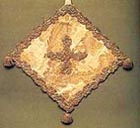
Epigonation. The gold ace-guipure. 1st half - the middle of the 18th century. The Western Europe |
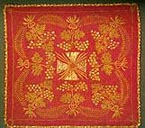
The small cover for Eucharist. The gold grid. The 40th of the 19th century |
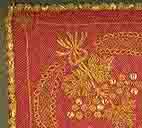
The small cover for Eucharist. The gold grid (fragment). The 40th of the 19th century |
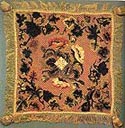
The small cover for Eucharist. The gold grid. The 19th century
|
In the 18th-19th centuries in the Western Europe and Russia, “blondes”, which have weaved from silk threads, used the big popularity. Their main feature consisted in contrast of very thin tulle background and a massive pattern. Quite often in it were intertwined the gold or silver threads, giving to a lace unique grace. In the museum collection, it is stored only two samples «gold blondes », which can be dated the middle of the 19th century presumably¬. One of them - the lacy ¬ edge, serving by furnish of the velvet chasuble of the beginning of the 20-th century, occurring from Optina Hermitage.
It is necessary especially to dwell on gold-silver lace-network of the 19th - the beginnings of the 20th century - last period in history of this kind of art. Hardly probable not unique sphere of its application at that time there was a church and ¬ country life. In art metal lace-network in the 19th – the beginning of the 20th century by tradition were engaged in female ¬ monasteries.
The veil and small covers for Eucharist from grey silk with a picturesque pattern of roses and the silver lace, enclosed by Sergiya Mother Superior of Khotkovo’s monastery are dated the end of the 19th - the beginning of the 20th century. The veil and small cover for Eucharist from silvery brocade with an embroidery multi-coloured silk and narrow gold edge with a pattern in the form of festoons have arrived in the Trinity-sergiev a monastery in 1903.
|
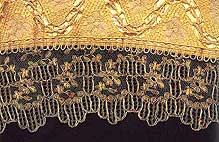
Chasuble (fragment). The beginning of the 19th century. The lace. The middle of the 19th century |
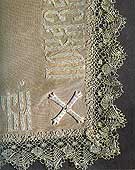
Veil (fragment). The silver lace. The end of the 19th century - the beginning of the 20th century. Products of Khotkovo skilled workers |
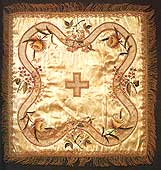
The small cover for Eucharist. The gold-silver lace. The beginning of the 20th century
|
|


